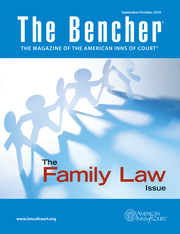Can You Believe It, People Still Text While Driving? Do you Do It?
The Bencher—September/October 2018
By Richard K. Herrmann, Esquire

 Not too long ago, I was standing outside my home when I watched a young girl riding over a speed bump on her bicycle while texting with one hand. An incredible feat. On the one hand, I found myself just shaking my head in disbelief; on the other hand, I could not understand how an obvious intelligent young person could pull a stunt like that in complete disregard for her own safety.
Not too long ago, I was standing outside my home when I watched a young girl riding over a speed bump on her bicycle while texting with one hand. An incredible feat. On the one hand, I found myself just shaking my head in disbelief; on the other hand, I could not understand how an obvious intelligent young person could pull a stunt like that in complete disregard for her own safety.
The incident reminded me of what I thought was the evolution of the awareness and mindfulness of distracted driving. I teach a course on Technology and the Law. Years ago, I would begin each semester by asking for a show of hands as to how many students drive while texting. When I began, the vast majority would raise their hands, setting the stage for the semester’s theme on the risks associated with the use of technology. I noticed, as the years passed, fewer and fewer students would raise their hands as the semester began. Last year, no hands were up at all, and I remarked how things have changed. One student in the back simply said, “It is not that we don’t do it; this is a law class and everyone knows enough not to admit it”.
So, I find myself continually amazed as to the dangers people place themselves and other in, when driving while texting. The law calls it “inattentive driving”. When a person is driving while intentionally taking his/her eyes off the road, there is nothing “inattentive” about it. Some states have addressed the issue but specifically making it a traffic offense use your mobile phone unless it is “hands free”. Obviously, considering today’s technology, this is not sufficient. Let me give you an example:
In May of this year, a police officer noticed a woman stopped at an intersection light. The driver caught the officer’s attention when he saw her looking down and a glow from an electronic device. After the light turned to green and the driver did not move; the officer shown his light to get her attention. Once the women cleared the intersection, he pulled her over. She was ticketed and fined $400. The women argued she was simply consulting her watch for the time but had to tap it twice. The judge did not accept the old “just looking at my watch” argument and found her guilty of distracted driving, noting an Apple watch is no more safe than a cell phone taped to your wrist. https://nationalpost.com/news/canada/a-cellphone-taped-to-someones-wrist-woman-looking-at-apple-iwatch-found-guilty-of-distracted-driving
Apple has been the target of litigation for a number of years, by those claiming it should “lock its iphone when in motion”. According to a recent AAA Foundation for Traffic Safety study, distracted driving now tops the most significant dangerous behavior lists, - even higher than driving while drinking or while using drugs. And yet, of the drivers polled in the study, more than “(49 percent) of drivers report recently talking on a hand-held phone while driving and nearly 35 percent have sent a text or email.” https://newsroom.aaa.com/2018/03/distraction-tops-drivers-list-growing-dangers-road/
The question arises, besides suing Apple and other device manufacturers for liability connected with distracted driving, what should lawyers do? And I am not talking about more advertising to represent injured victims of distracted drivers. We ought to get in front of this. We, as an organization, should make it clear that this form of distracted driving is not acceptable behavior. We don’t want our partners doing it, and we don’t want our associates engaging in it. In August 2012, the American Bar Association amended the Rules of Professional Conduct. Comment 8 to Rule 1.1 provides “ [8] To maintain the requisite knowledge and skill, a lawyer should keep abreast of changes in the law and its practice, including the benefits and risks associated with relevant technology.” If there is any risk that can be associated with inattentive driving, it is using an electronic device such as a cell phone or smart watch. And if a member of the Bar is found liable for engaging in this form of distracted driving, the issue should be brought to the attention of Disciplinary Counsel as a violation of Rule 1.1, comment 8. We need to step up and be leaders, for the sake of our communities, our clients and our families; we need to Raise the Bar.
Richard K. Herrmann, Esquire is a partner in the firm of Morris James in Wilmington, Delaware. He is a Master of the Bench member of the Richard K. Herrmann Technology AIC.